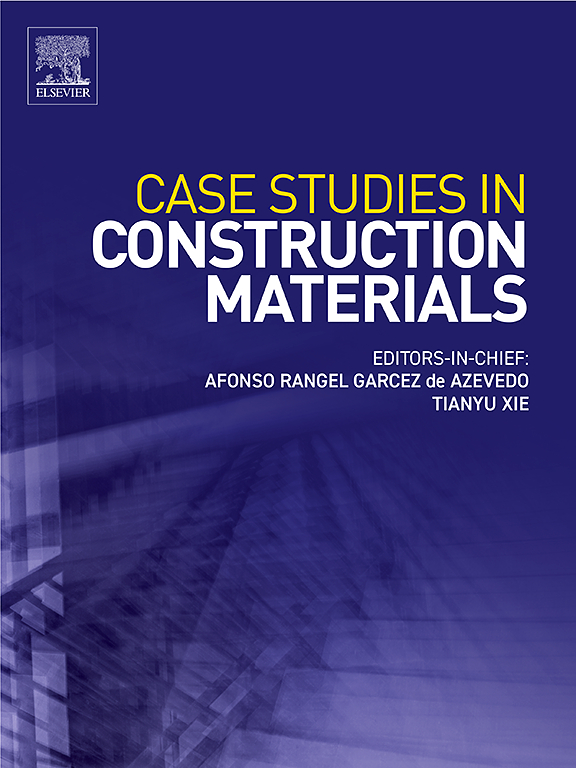使用海水、海砂和超细棕榈油燃料灰的可持续混凝土:机械性能和耐久性
IF 6.5
2区 工程技术
Q1 CONSTRUCTION & BUILDING TECHNOLOGY
引用次数: 0
摘要
混凝土生产是二氧化碳排放和自然资源枯竭的重要因素,如河砂和淡水。然而,这些环境影响可以通过在混凝土中掺入海水、海砂和农业废弃物来减轻。棕榈油燃料灰(POFA)是棕榈油生产的一种农业副产品,通常未经事先处理就被丢弃在空地和垃圾填埋场,导致环境污染。细磨成超细POFA (UPOFA)后,材料性能和火山灰反应得到改善,适合部分替代水泥。用圆盘磨机研磨后,UPOFA颗粒的细度约为50 μm。然而,对海水、海砂和UPOFA配制的混凝土的力学性能和耐久性研究有限。本研究调查了POFA作为部分水泥替代品(10 %,20 %和30 %)在与海水和海砂混合的混凝土中的使用,重点是其在可持续性方面的作用。本研究进一步评价了加入UPOFA作为水泥替代品的海水海砂混凝土的力学性能和耐久性。结果表明,掺入含有10 % UPOFA的海水可显著提高混凝土的力学性能,在28 d (UP10-RS-SW)时抗压强度最高,达到37.95 MPa,比普通混凝土(N-RS-TW)的抗压强度27.13 MPa提高10.82 MPa(39.90 %)。此外,加入10% % UPOFA作为水泥替代品,可提高抗压强度、超声波脉冲速度和耐腐蚀性,同时降低吸水率、孔隙率和氯化物渗透深度。本文章由计算机程序翻译,如有差异,请以英文原文为准。
Sustainable concrete using seawater, sea-sand, and ultrafine palm oil fuel ash: Mechanical properties and durability
Concrete production is a significant contributor to CO2 emissions and the depletion of natural resources, such as river sand and freshwater. However, these environmental impacts can be mitigated by incorporating seawater, sea-sand, and agricultural waste into concrete. Palm-oil fuel ash (POFA), an agricultural by-product from palm oil production, is often discarded in open spaces and landfills without prior processing, leading to environmental contamination. When finely ground into ultrafine POFA (UPOFA), it enhances material properties and pozzolanic reactions, making it suitable as a partial replacement for cement. After grinding with a disc mill, the UPOFA particles achieve a fineness of approximately 50 μm. However, limited research exists on the mechanical properties and durability of concrete made with seawater, sea-sand, and UPOFA. This study investigates the use of POFA as a partial cement replacement (10 %, 20 %, and 30 %) in concrete mixed with seawater and sea-sand, focusing on its role in sustainability. The study further evaluates the mechanical properties and durability of seawater sea-sand concrete incorporating UPOFA as a cement replacement. The results indicate that using seawater for mixing concrete containing 10 % UPOFA significantly enhances its mechanical properties, with the highest compressive strength of 37.95 MPa at 28 d (UP10-RS-SW), a 10.82 MPa (39.90 %) increase compared to the normal concrete (N-RS-TW), which had a compressive strength of 27.13 MPa. Additionally, the incorporation of 10 % UPOFA as a cement replacement improved compressive strength, ultrasonic pulse velocity, and corrosion resistance while reducing water absorption, porosity, and chloride penetration depth.
求助全文
通过发布文献求助,成功后即可免费获取论文全文。
去求助
来源期刊

Case Studies in Construction Materials
Multiple-
CiteScore
7.60
自引率
19.40%
发文量
842
审稿时长
63 days
期刊介绍:
Case Studies in Construction Materials provides a forum for the rapid publication of short, structured Case Studies on construction materials. In addition, the journal also publishes related Short Communications, Full length research article and Comprehensive review papers (by invitation).
The journal will provide an essential compendium of case studies for practicing engineers, designers, researchers and other practitioners who are interested in all aspects construction materials. The journal will publish new and novel case studies, but will also provide a forum for the publication of high quality descriptions of classic construction material problems and solutions.
 求助内容:
求助内容: 应助结果提醒方式:
应助结果提醒方式:


